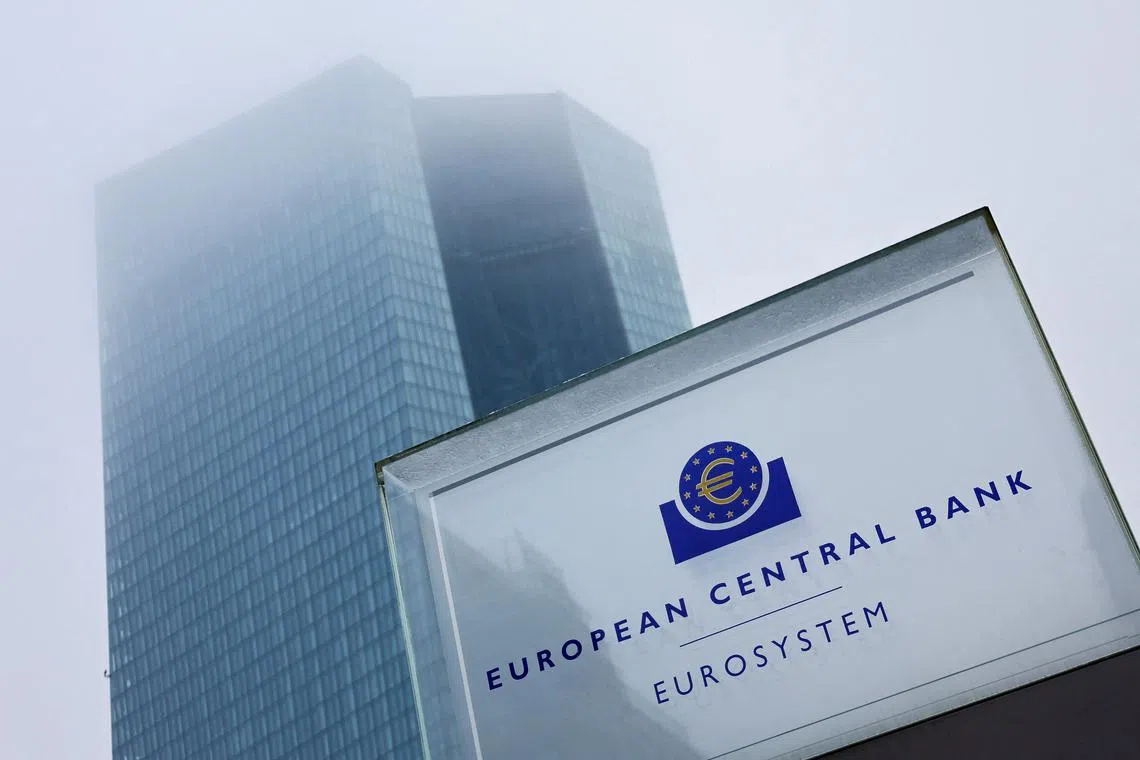EU central bank makes back-to-back interest rate cuts as inflation falls
Sign up now: Get ST's newsletters delivered to your inbox

Going into 2025, observers expected the ECB to keep lowering interest rates at a steady pace with a string of cuts.
PHOTO: REUTERS
Follow topic:
FRANKFURT – The European Central Bank cut interest rates again on Oct 17, upping the tempo at which it is lowering borrowing costs as inflation in the eurozone cools faster than expected.
The Frankfurt-based institution reduced rates by a quarter point, following a cut of the same size at its last meeting in September.
Oct 17’s move was the first time that the ECB has cut rates back to back since it started its cycle of easing rates in response to declining inflation.
After peaking at 4 per cent, the ECB’s benchmark deposit rate sits at 3.25 per cent following the latest cut.
The decision came after a late downwards revision to September’s inflation data in the euro zone on Oct 17.
Consumer prices in the bloc rose by 1.7 per cent year on year in September, according to the EU’s data agency Eurostat, 0.1 percentage points less than the initial estimate.
Before the change, September’s reading was already the first time in three years that inflation in the eurozone had dipped below the ECB’s two-per cent target.
The incoming data showed that the process of cooling consumer prices was “on track”, the ECB said in a statement.
“Inflation is expected to rise in the coming months, before declining to target in the course of next year,” the ECB said.
Slovenia meeting
ECB rate-setters met in Slovenia to discuss their next move, as they made one of their regular tours away from the institution’s headquarters in Frankfurt.
Oct 17’s decision was the third time that they have cut since rates reached their peak.
The bank cranked rates up higher and faster than ever before in response to soaring inflation in the wake of the Covid-19 pandemic and the Russian invasion of Ukraine.
But recent, lower-than-expected inflation figures have added to the sense among policymakers that consumer prices are back under control.
Weakness in the euro zone economy gave the ECB a further reason to lower borrowing costs and bring some relief to households and businesses.
“Recent downside surprises in indicators of economic activity” supported confidence that inflation was heading durably towards two per cent, the ECB said.
The move to follow up September’s cut with another reduction suggested that the ECB was “much more concerned about the euro zone’s growth outlook” than before, ING analyst Carsten Brzeski said.
With that came the risk of “inflation undershooting the target”, Mr Brzeski said.
“It’s hard to see how today’s rate cut cannot be seen as a signal that the ECB is now in a hurry to bring interest rates down,” he said.
‘Data-dependant’
The ECB itself said it would “continue to follow a data-dependent and meeting-by-meeting approach”. The bank was not “pre-committing to a particular rate path”, it added.
ECB president Christine Lagarde was due to speak following the decisions, with analysts eager to parse through her comments in Slovenia for an indication of the thinking among ECB policymakers about the future path of rates.
She was unlikely to “correct market expectations for another 25 basis point move” at the ECB’s next meeting in December, Berenberg bank analyst Holger Schmieding said.
Going into 2025, observers expected the ECB to keep lowering interest rates at a steady pace with a string of cuts.
The ECB might even provide a hint that it would pursue further reductions “until they reach a neutral rate of two percent to 2.5 percent by the middle of next year”, said director of economic studies Eric Dor at the IESEG business school in France. AFP

